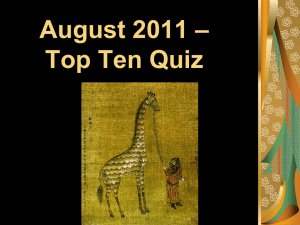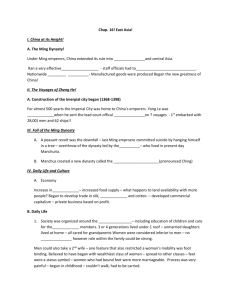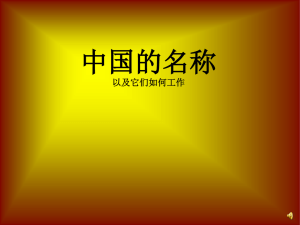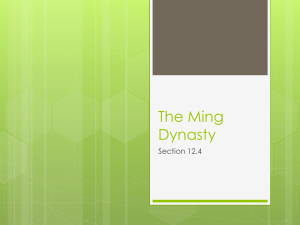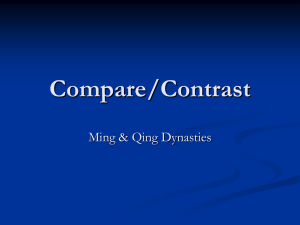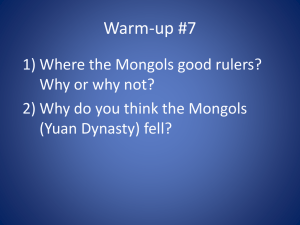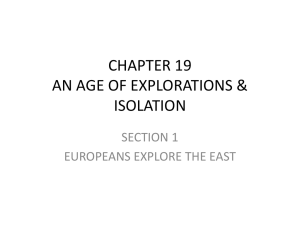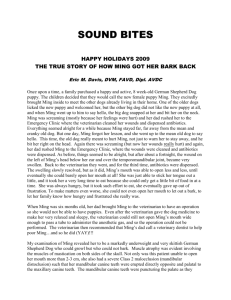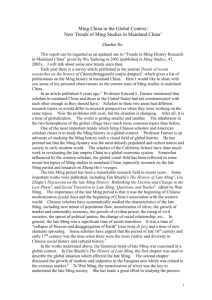Ming scholars in Europe
advertisement
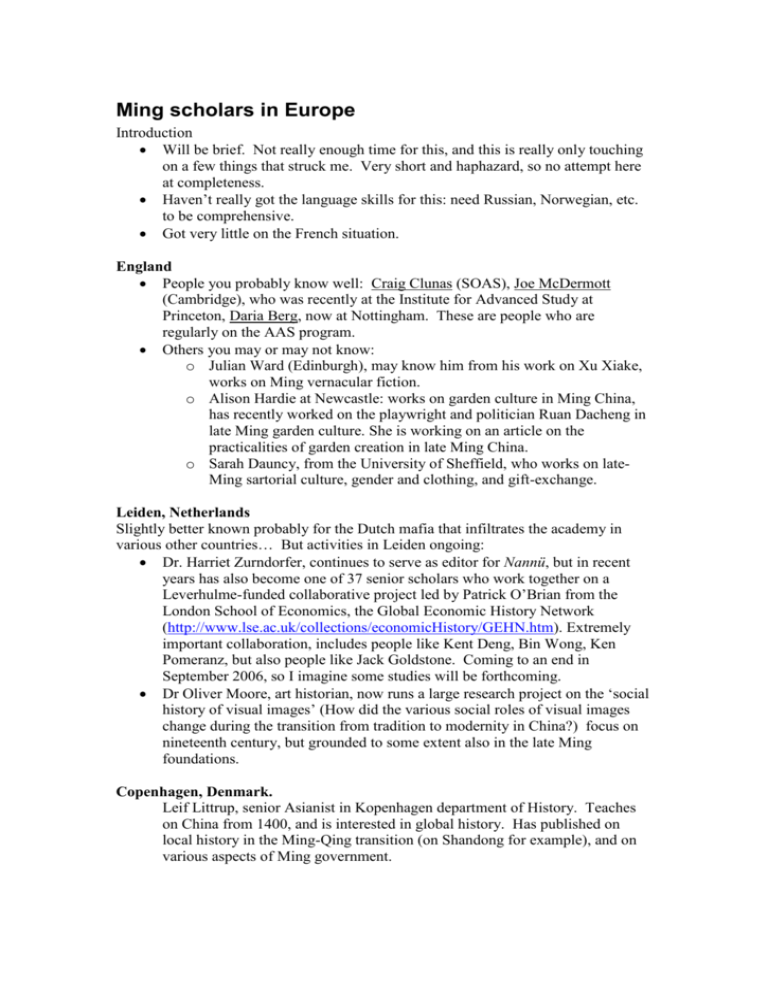
Ming scholars in Europe Introduction Will be brief. Not really enough time for this, and this is really only touching on a few things that struck me. Very short and haphazard, so no attempt here at completeness. Haven’t really got the language skills for this: need Russian, Norwegian, etc. to be comprehensive. Got very little on the French situation. England People you probably know well: Craig Clunas (SOAS), Joe McDermott (Cambridge), who was recently at the Institute for Advanced Study at Princeton, Daria Berg, now at Nottingham. These are people who are regularly on the AAS program. Others you may or may not know: o Julian Ward (Edinburgh), may know him from his work on Xu Xiake, works on Ming vernacular fiction. o Alison Hardie at Newcastle: works on garden culture in Ming China, has recently worked on the playwright and politician Ruan Dacheng in late Ming garden culture. She is working on an article on the practicalities of garden creation in late Ming China. o Sarah Dauncy, from the University of Sheffield, who works on lateMing sartorial culture, gender and clothing, and gift-exchange. Leiden, Netherlands Slightly better known probably for the Dutch mafia that infiltrates the academy in various other countries… But activities in Leiden ongoing: Dr. Harriet Zurndorfer, continues to serve as editor for Nannü, but in recent years has also become one of 37 senior scholars who work together on a Leverhulme-funded collaborative project led by Patrick O’Brian from the London School of Economics, the Global Economic History Network (http://www.lse.ac.uk/collections/economicHistory/GEHN.htm). Extremely important collaboration, includes people like Kent Deng, Bin Wong, Ken Pomeranz, but also people like Jack Goldstone. Coming to an end in September 2006, so I imagine some studies will be forthcoming. Dr Oliver Moore, art historian, now runs a large research project on the ‘social history of visual images’ (How did the various social roles of visual images change during the transition from tradition to modernity in China?) focus on nineteenth century, but grounded to some extent also in the late Ming foundations. Copenhagen, Denmark. Leif Littrup, senior Asianist in Kopenhagen department of History. Teaches on China from 1400, and is interested in global history. Has published on local history in the Ming-Qing transition (on Shandong for example), and on various aspects of Ming government. German situation: 1) feudal nature of relationships between professors and their students, and 2) large state-funded often collaborative research projects. Well publicised, and if interested in the field, that’s the place to look. Marburg, Germany Monika Übelhör has now retired. Dr. Ralph Kauz (http://www.uni-marburg.de/fb06/sinologie/personalia/kauz) Works on relations between China, Central Asia and Middle East. Has published, amongst other things, on Yuan and Ming sources on Hormuz, on Zheng He, on trade in textiles in the 14th and 15th centuries, and on postal stations in Ming China. Leipzig, Germany Dr. Kai Filipiak, Leipzig Institute of East Asian Studies Runs a large research project, entitled “Conflicts in the Chinese Society of Ming times (1368-1644) and their effects on politics and power structures.” Seeks to challenge the idea of Ming stability by looking at conflict in a variety of contexts and over the entire duration of Ming rule. Würzburg, Germany Active place of research under dynamic guidance of Dieter Kuhn, who is I suppose mostly a scholar of the Song, and who is here at AAS. Heads the Würzburger Sinologische Schriften, which publishes very prolifically on pre-modern China. ‘Produced’ (in the slightly feudal way that senior German scholars ‘produce’ students) number of now very prominent students, such as Ina Asim, Angela Schottenhammer, Christiane Reinhold, Among them also number of Ming scholars: Dagmar Schäfer, who has published a book on the state manufacture of silk during the Ming, published in the Würzburger Sinologische Schriften. Also led to the publication of a book entitled Weaving an Economic Pattern in Ming Times (1368-1644). The Production of Silk Weaves in the State-Owned Silk Workshops. Dagmar has also published on the Tiangong kaiwu, and has recently accepted a prestigious position in the history of science in Berlin. Tübingen, Germany Runs a large research project on finance and monetary policy from C17 to C19. led by professor Hans Ulrich Vogel, together with Dr Christine Moll-Murata. Strong background in history of science, but also looks at Chinese integration in the world economy. Munich, Germany Large research project run by Angela Schottenhammer, with seven members of staff appointed to work on this: entitled “The East Asian 'Mediterranean', c. 1500-1800: A New Quality in the Development of its Neighbouring Countries.” http://www.eamh.net/index.html Fascinating project, uses the Braudellian idea of a meditteranian region, looks in a broadly interdisciplinary way (textual as well as archeological sources) at the entire East Asian region as integrated and connected. Work together with the Munich centre for History of Medicine, because medine was one of the widely traded commodities. Looks at exchange of commodities, knowledge, and technologies.
